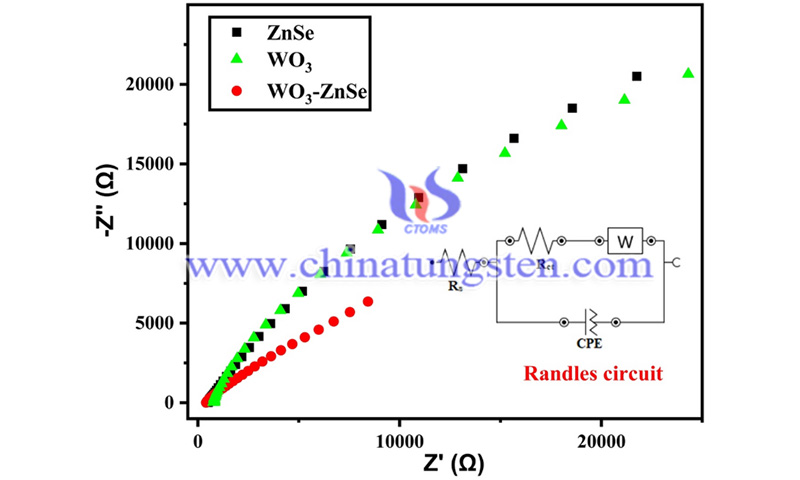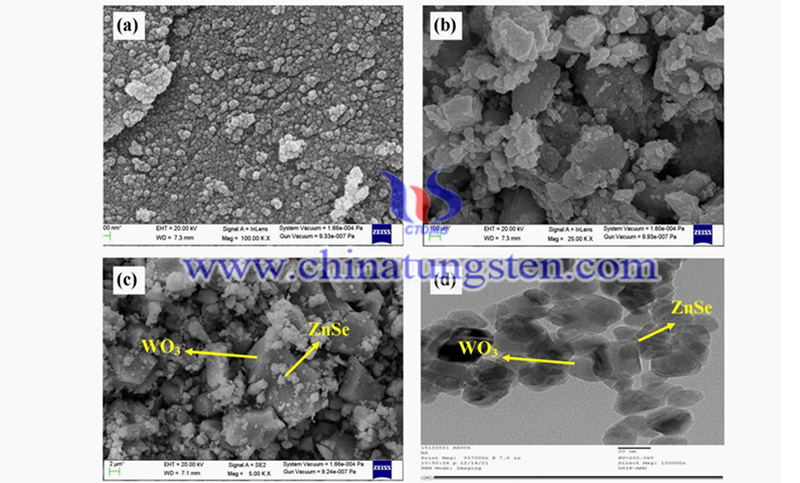Growth of Crystalline WO3-ZnSe Nanocomposites
- Details
- Category: Tungsten Information
- Published on Friday, 01 April 2022 17:04
In a study led by researchers at the School of Chemical Studies, Jiwaji University, India, novel growth of WO3-ZnSe nanocomposites was performed under subcritical conditions by a simple, low-cost hydrothermal process, and the first characterization of the products-completed in just 5 hours is reported: X-ray diffraction, scanning electron microscopy (SEM), optical studies and Fourier transform analysis.
The study titled “Growth of crystalline WO3‑ZnSe nanocomposites: an approach to optical, electrochemical, and catalytic properties” has been published in the journal Nature Scientific Reports (2022) 12. The study was carried out by Insaaf Assadullah et al. This study demonstrates the effects of ZnSe on the structural, morphological, compositional, optical, and catalytic properties of WO3 metal oxide materials grown in a wide bandgap hexagonal crystal structure and modified by ZnSe to form nanoscale composite nanostructures.
The electrochemical properties of the prepared materials were investigated by cyclic voltammetry, and it was found that the synthesized materials exhibited significant electrochemical supercapacitance activity. Furthermore, the composite nanostructures showed excellent photocatalytic activity for the degradation of phenol, with almost 93% of phenol degraded with good recyclability and stability.

Environmental pollution and energy crisis are the main problems facing mankind in all aspects of the biosphere. Rapid industrialization and expanding urbanization have resulted in disturbing the harmony of nature and adding harmful pollutants to the environmental medium.
Various contaminants such as pharmaceutical effluents, phenols, pesticides, dyes, fungicides, and phthalates have been added to soil and water bodies, deteriorating their quality and standards. In addition to pollutants, the prevalence of different endocrine disruptors such as 17-beta-estradiol and bisphenol A (BPA) in the environment has led to serious health problems. Researchers around the globe are working to create modern and advanced technologies to purify and mitigate the harmful effects of these pollutants.
Among the advanced technologies, photocatalytic degradation using semiconductor nanoparticles is considered a sustainable technology for degrading many organic and inorganic pollutants. Although photocatalysis is considered a landmark technology for degrading pollutants, its application is limited by wide bandgap semiconductor photocatalysts.
Semiconductor nanoparticles have received a lot of attention in the field of photocatalysis due to their awesome morphology and special properties. The special functions of semiconductor photocatalysts have been significantly evaluated in the regeneration and remediation of polluted environments. However, these nanoparticles have serious defects in light absorption in the UV region.
In addition, nanomaterials show promising applications in energy production and energy storage due to their large specific surface area, great chemical stability, excellent mechanical properties, and excellent electron mobility. Various transition metal oxides have been used for energy storage and as electrode materials for supercapacitors. However, the problem of transition metal oxides is the limited DC conductivity and aggregation behavior.

In recent years, tungsten oxide (WO3) has attracted the interest of many researchers due to its versatility and multiple properties. WO3 is an n-type semiconductor and a potential visible-light photocatalyst. It is considered one of the most promising semiconductor photocatalysts for degrading organic compounds due to its small bandgap (ranging from 2.4 to 2.8 eV), low cost, and high stability in aqueous solutions under acidic conditions.
Tungsten oxide has been used as an electrochemical, photocatalytic, and gas detection tool. In addition, a new report shows that tungsten oxide has biophotocatalytic properties, while its properties also indicate potential applications in nano-bio-innovations. Zinc selenide (ZnSe) has also been developed as a photocatalytic material with a bandgap of 2.7 eV at room temperature and a huge excitation limit energy of 21 meV.
To improve the activity of the nanostructures, the researchers developed WO3-ZnSe nanocomposites, and apply them to a variety of applications such as electrochemical, photoluminescent, and photocatalytic applications. The composites were fabricated to have advantages over their individual counterparts in terms of light absorption, redox activity, and interfacial charge transfer. In terms of electrochemical activity, the WO3-ZnSe composites showed good photocatalytic and capacitive behavior with 93% phenol degradation in 105 min.
The growth of WO3-ZnSe nanocomposites by a simple, low-cost hydrothermal process under subcritical conditions is reported for the first time. Comprehensive morphological characterization revealed the crystalline nature of the synthesized nanostructures. The wide bandgap nanomaterials were modified by fabricating composites.
The fabricated modified nanomaterials have many applications, exhibiting high crystallinity and outstanding photocatalytic activity, which is due to the increased surface area after composite formation. In addition, the nanostructures show great charge storage properties by cyclic voltammetry analysis. According to the International Commission on Illumination (CIE), the synthesized nanomaterials show blue emissions and are suitable for blue LEDs.
- Tungsten Manufacturer & Supplier, Chinatungsten Online: www.chinatungsten.com
- Tungsten News & Prices of China Tungsten Industry Association: www.ctia.com.cn
- Molybdenum News & Price: news.molybdenum.com.cn
- Tel.: 86 592 5129696; Fax: 86 592 5129797; Email: sales@chinatungsten.com



 sales@chinatungsten.com
sales@chinatungsten.com